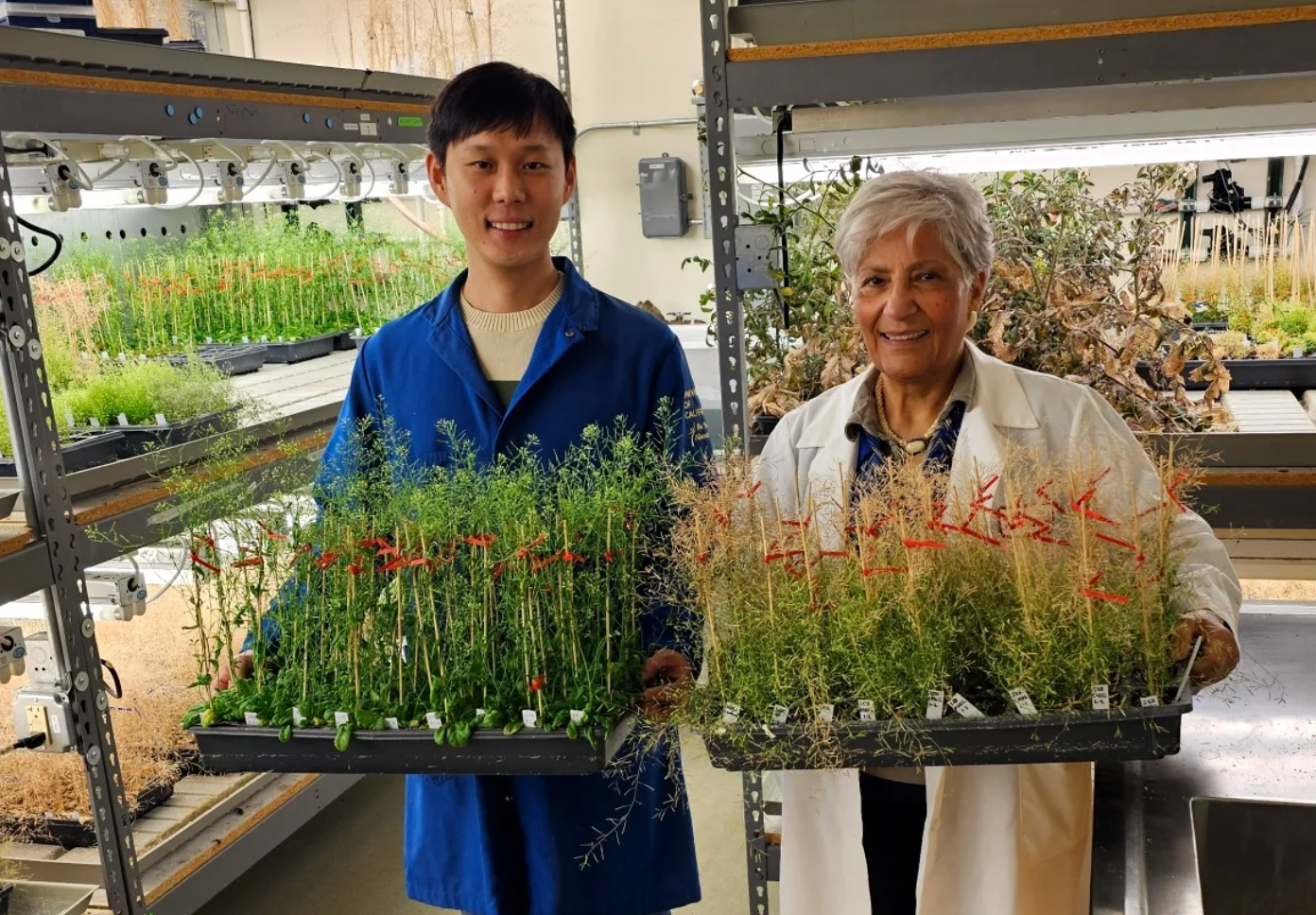Unexpected plant cell discovery may hold the key to extending human lifespans
Unexpected study brought forth an astonishing revelation: a long-known plant cell organelle, the Golgi body, plays a pivotal role in aging

Researchers Heeseung Choi and Katie Dehesh holding young, green and old, yellow arabidopsis plants in the laboratory. (Katie Dehesh/UCR)
Plant cells, despite their stationary nature, are incredibly complex and dynamic. For over a century, scientists have been studying various aspects of these cells, unraveling their mysteries step by step.
However, recent research at the University of California, Riverside (UCR) and published in the Nature Plants journal has brought forth an astonishing revelation: a long-known plant cell organelle, the Golgi body, plays a pivotal role in aging.
This unexpected discovery has sparked excitement among scientists and holds promising implications for understanding the aging process in humans as well.
The initial goal of the UCR research team was to gain a broader understanding of how plant cells respond to stressors like infections, high salt levels, or insufficient light. In a stroke of serendipity, they stumbled upon the Golgi body, a cellular structure often likened to a stack of deflated balloons or disheveled lasagna.
Related Stories:
The Golgi body comprises a series of cup-shaped sacs covered with membranes and acts as a sorting hub for various molecules within the cell, ensuring their delivery to the right destinations.
Katie Dehesh, a distinguished professor of molecular biochemistry at UCR and co-author of the study, expressed her excitement: "For us, this finding is a big deal. For the first time, we have defined the profound importance of an organelle in the cell that was not previously implicated in the process of aging."
The Golgi body, analogous to a cellular post office, packages and dispatches proteins and lipids to their designated locations. However, when this organelle becomes damaged, it can disrupt the cell's activities, potentially jeopardizing its overall functionality and health. "A damaged Golgi can create confusion and trouble in the cell's activities, affecting how the cell works and stays healthy," explains Heeseung Choi, a researcher in UCR's Botany and Plant Sciences Department and the first author of the study.
The cog7 mutant displays constitutively induced RSRE and accelerated dark-induced senescence. (CREDIT: Plants journal)
Intriguingly, the Golgi body depends on a protein called COG to facilitate its operations. COG serves as the cellular postal worker, overseeing the movement of tiny sac-like "envelopes" responsible for transporting various molecules within the cell. Additionally, COG aids in attaching sugars to proteins or lipids before they are dispatched elsewhere within the cell, a process known as glycosylation, critical for numerous biological functions, including immune responses.
To delve deeper into the impact of COG on plant cells, the research team engineered plants incapable of producing this vital protein. Under normal growing conditions, these modified plants thrived and remained indistinguishable from their unmodified counterparts. However, a lack of light proved to be their downfall.
COG-imposed Golgi functional integrity determines the onset of dark-induced senescence. (CREDIT: Plants journal)
Without adequate sunlight to generate sugars for growth, the leaves of the COG-deficient plants began to exhibit telltale signs of aging: turning yellow, wrinkling, and thinning. These symptoms, typically seen in unmodified plants after approximately nine days of darkness, manifested in just three days in the mutants.
Remarkably, reversing the genetic mutation and reintroducing the COG protein into the plants swiftly rejuvenated them. As Dehesh describes it, "It's like nothing happened to them once we reversed the mutation." Choi emphasizes, "These responses highlight the critical importance of the COG protein and normal Golgi function in stress management."
What makes this discovery particularly thrilling is that Golgi bodies are not exclusive to plant cells; they are found in human cells and virtually all eukaryotic organisms. This commonality opens up exciting possibilities for using plants as a model to explore the intricacies of the Golgi's role in aging in humans. Consequently, the research team is planning further studies to decipher the molecular mechanisms underlying the findings of this study.
Dehesh underscores the broader implications of this breakthrough: "Not only does our research advance our knowledge about how plants age, but it could also provide crucial clues about aging in humans. When the COG protein complex doesn't work properly, it might make our cells age faster, just like what we saw in plants when they lacked light. This breakthrough could have far-reaching implications for the study of aging and age-related diseases."
As scientists continue to unravel the mysteries of plant cells, they may unlock profound insights into the aging process, shedding light on ways to promote healthier aging not just in plants but also in humans and other organisms. This serendipitous discovery marks a significant step forward in our quest to understand the fundamental processes governing life and aging.
Note: Materials provided above by The Brighter Side of News. Content may be edited for style and length.
Like these kind of feel good stories? Get the Brighter Side of News' newsletter.
Joshua Shavit
Science & Technology Writer | AI and Robotics Reporter
Joshua Shavit is a Los Angeles-based science and technology writer with a passion for exploring the breakthroughs shaping the future. As a contributor to The Brighter Side of News, he focuses on positive and transformative advancements in AI, technology, physics, engineering, robotics and space science. Joshua is currently working towards a Bachelor of Science in Business Administration at the University of California, Berkeley. He combines his academic background with a talent for storytelling, making complex scientific discoveries engaging and accessible. His work highlights the innovators behind the ideas, bringing readers closer to the people driving progress.



